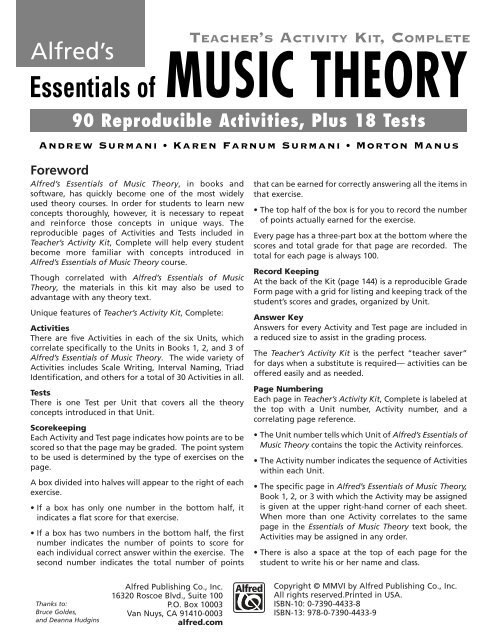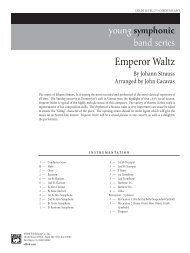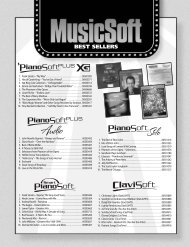Essentials of MUSIC THEORY - Stagepass.com
Essentials of MUSIC THEORY - Stagepass.com
Essentials of MUSIC THEORY - Stagepass.com
You also want an ePaper? Increase the reach of your titles
YUMPU automatically turns print PDFs into web optimized ePapers that Google loves.
TEACHER’S ACTIVITY KIT, COMPLETE<br />
Alfred’s<br />
<strong>MUSIC</strong> <strong>THEORY</strong><br />
<strong>Essentials</strong> <strong>of</strong><br />
90 Reproducible Activities, Plus 18 Tests<br />
Andrew Surmani • Karen Farnum Surmani • Morton Manus<br />
Foreword<br />
Alfred’s <strong>Essentials</strong> <strong>of</strong> Music Theory, in books and<br />
s<strong>of</strong>tware, has quickly be<strong>com</strong>e one <strong>of</strong> the most widely<br />
used theory courses. In order for students to learn new<br />
concepts thoroughly, however, it is necessary to repeat<br />
and reinforce those concepts in unique ways. The<br />
reproducible pages <strong>of</strong> Activities and Tests included in<br />
Teacher’s Activity Kit, Complete will help every student<br />
be<strong>com</strong>e more familiar with concepts introduced in<br />
Alfred’s <strong>Essentials</strong> <strong>of</strong> Music Theory course.<br />
Though correlated with Alfred’s <strong>Essentials</strong> <strong>of</strong> Music<br />
Theory, the materials in this kit may also be used to<br />
advantage with any theory text.<br />
Unique features <strong>of</strong> Teacher’s Activity Kit, Complete:<br />
Activities<br />
There are five Activities in each <strong>of</strong> the six Units, which<br />
correlate specifically to the Units in Books 1, 2, and 3 <strong>of</strong><br />
Alfred’s <strong>Essentials</strong> <strong>of</strong> Music Theory. The wide variety <strong>of</strong><br />
Activities includes Scale Writing, Interval Naming, Triad<br />
Identification, and others for a total <strong>of</strong> 30 Activities in all.<br />
Tests<br />
There is one Test per Unit that covers all the theory<br />
concepts introduced in that Unit.<br />
Scorekeeping<br />
Each Activity and Test page indicates how points are to be<br />
scored so that the page may be graded. The point system<br />
to be used is determined by the type <strong>of</strong> exercises on the<br />
page.<br />
A box divided into halves will appear to the right <strong>of</strong> each<br />
exercise.<br />
• If a box has only one number in the bottom half, it<br />
indicates a flat score for that exercise.<br />
• If a box has two numbers in the bottom half, the first<br />
number indicates the number <strong>of</strong> points to score for<br />
each individual correct answer within the exercise. The<br />
second number indicates the total number <strong>of</strong> points<br />
that can be earned for correctly answering all the items in<br />
that exercise.<br />
• The top half <strong>of</strong> the box is for you to record the number<br />
<strong>of</strong> points actually earned for the exercise.<br />
Every page has a three-part box at the bottom where the<br />
scores and total grade for that page are recorded. The<br />
total for each page is always 100.<br />
Record Keeping<br />
At the back <strong>of</strong> the Kit (page 144) is a reproducible Grade<br />
Form page with a grid for listing and keeping track <strong>of</strong> the<br />
student’s scores and grades, organized by Unit.<br />
Answer Key<br />
Answers for every Activity and Test page are included in<br />
a reduced size to assist in the grading process.<br />
The Teacher’s Activity Kit is the perfect “teacher saver”<br />
for days when a substitute is required— activities can be<br />
<strong>of</strong>fered easily and as needed.<br />
Page Numbering<br />
Each page in Teacher’s Activity Kit, Complete is labeled at<br />
the top with a Unit number, Activity number, and a<br />
correlating page reference.<br />
• The Unit number tells which Unit <strong>of</strong> Alfred’s <strong>Essentials</strong> <strong>of</strong><br />
Music Theory contains the topic the Activity reinforces.<br />
• The Activity number indicates the sequence <strong>of</strong> Activities<br />
within each Unit.<br />
• The specific page in Alfred’s <strong>Essentials</strong> <strong>of</strong> Music Theory,<br />
Book 1, 2, or 3 with which the Activity may be assigned<br />
is given at the upper right-hand corner <strong>of</strong> each sheet.<br />
When more than one Activity correlates to the same<br />
page in the <strong>Essentials</strong> <strong>of</strong> Music Theory text book, the<br />
Activities may be assigned in any order.<br />
• There is also a space at the top <strong>of</strong> each page for the<br />
student to write his or her name and class.<br />
Thanks to:<br />
Bruce Goldes,<br />
and Deanna Hudgins<br />
Alfred Publishing Co., Inc.<br />
16320 Roscoe Blvd., Suite 100<br />
P.O. Box 10003<br />
Van Nuys, CA 91410-0003<br />
alfred.<strong>com</strong><br />
Copyright © MMVI by Alfred Publishing Co., Inc.<br />
All rights reserved.Printed in USA.<br />
ISBN-10: 0-7390-4433-8<br />
ISBN-13: 978-0-7390-4433-9
Unit 2 ACTIVITY 1 Name/Class__________________________________<br />
Counting Beats in 4 Time<br />
4<br />
q q q q<br />
∑ h<br />
q q h<br />
h Ó<br />
q h q<br />
h Œ<br />
q h q<br />
w<br />
q Œ q Œ<br />
Πq h<br />
q q h q<br />
q q Πq<br />
Ó q q<br />
h h<br />
q h Œ<br />
Ó h<br />
∑<br />
Πw<br />
h Πq<br />
Œ q Ó Ó<br />
Use after <strong>com</strong>pleting page 13.<br />
Place an “X” through each measure showing an incorrect number <strong>of</strong> beats in<br />
4 4 time.<br />
h q q w q<br />
q Ó q Œ h Œ<br />
q h<br />
h q h<br />
Ó q h q q q Œ<br />
Œ q Œ q h Ó<br />
h ∑<br />
q Œ Ó<br />
Œ q h q qÓ<br />
10–100<br />
Copyright © MMVI by Alfred Publishing Co., Inc.<br />
9
Unit 2<br />
ACTIVITY 5 Name/Class__________________________________<br />
Music Crossword Puzzle<br />
1<br />
2<br />
3<br />
Use after <strong>com</strong>pleting page 14.<br />
4<br />
5<br />
6<br />
7<br />
8<br />
9<br />
10<br />
11<br />
12<br />
13<br />
14<br />
15<br />
16<br />
17<br />
18<br />
19<br />
ACROSS<br />
2. Lines that extend the<br />
lower and upper<br />
ranges <strong>of</strong> a staff<br />
(2 words)<br />
5. Rest that receives 1<br />
beat <strong>of</strong> silence in 4 4<br />
time (2 words)<br />
8. Symbol for a musical<br />
silence<br />
9. The length <strong>of</strong> a note<br />
10. Two stacked numbers<br />
appearing after a clef<br />
sign (2 words)<br />
14. One whole rest = _____<br />
half rests.<br />
Copyright © MMVI by Alfred Publishing Co., Inc.<br />
16. Rest that receives 4<br />
beats <strong>of</strong> silence in<br />
4 4 time (2 words)<br />
17. Another name for<br />
measure<br />
18. Rest that receives 2<br />
beats <strong>of</strong> silence in<br />
4 time (2 words)<br />
19. Line that divides music<br />
into equal sections<br />
(2 words)<br />
DOWN<br />
1. Note that receives<br />
4 beats in 4 4 time<br />
(2 words)<br />
13<br />
3. The bass and treble<br />
staffs connected by a<br />
brace and bar line<br />
(2 words)<br />
4. Note that 4 receives 1<br />
beat in time (2 words)<br />
6. The lines and spaces<br />
music is written on<br />
7. ___ quarter rests = one<br />
whole rest<br />
9. Lines at the end <strong>of</strong> a<br />
piece <strong>of</strong> music<br />
(2 words)<br />
11. If a note appears on or<br />
above the 3rd line <strong>of</strong><br />
the staff, the stem<br />
extends ______.<br />
12. An introduction given<br />
before a piece <strong>of</strong> music<br />
that is performed to<br />
indicate the tempo<br />
13. The area between<br />
bar lines<br />
15. Note that receives<br />
2 beats in 4 4 time<br />
(2 words)<br />
5–100
Unit 3<br />
ACTIVITY 5 Name/Class__________________________________<br />
Music Crossword Puzzle<br />
1 2<br />
3<br />
4 5<br />
Use after <strong>com</strong>pleting page 20.<br />
6<br />
7<br />
8<br />
9<br />
10<br />
11<br />
12<br />
13<br />
14<br />
15<br />
16<br />
17<br />
18<br />
19<br />
20<br />
ACROSS<br />
1. A _____ rest is used<br />
for a full measure <strong>of</strong><br />
rest.<br />
4. On _____<br />
instruments, a slur<br />
indicates a group <strong>of</strong><br />
notes to be played<br />
in one bow.<br />
7. Albert von Tilzer<br />
<strong>com</strong>posed the song<br />
“Take Me Out to<br />
the_____ _____ .“<br />
11. In 3 4 time, two tied<br />
dotted half notes<br />
equal _____ beats.<br />
13. A curved line that<br />
joins two notes <strong>of</strong><br />
the same pitch<br />
14. In 3 4 and<br />
4 4 time, this<br />
note receives 3<br />
beats. (3 words)<br />
16. A half note receives<br />
_____ beats in 3 4<br />
time.<br />
17. The tie should<br />
always be written<br />
on the _____ side<br />
from the note<br />
stems.<br />
18. When stem<br />
direction is mixed,<br />
the slur is written<br />
_____ the notes.<br />
20. A curved line that<br />
smoothly connects<br />
two or more notes<br />
<strong>of</strong> different pitches<br />
2. Two quarter rests<br />
equal the value <strong>of</strong><br />
one _____ rest.<br />
3. To play or sing notes<br />
smoothly connected<br />
5.<br />
DOWN<br />
4<br />
2<br />
and 3 4 are referred<br />
to as _____ _____ .<br />
6. “Aura Lee” is an<br />
_____ folk song.<br />
8. In 2 4 time, the _____<br />
note receives 1 beat.<br />
9. A whole rest<br />
receives _____ beats<br />
in 3 4 time.<br />
10. On _____<br />
instruments, only<br />
the first note <strong>of</strong> a<br />
group <strong>of</strong> slurred<br />
notes should be<br />
tongued.<br />
12. On _____<br />
instruments, slurs<br />
indicate when to lift<br />
the hands.<br />
15. If the quarter note<br />
receives 1 beat, then<br />
the bottom number<br />
<strong>of</strong> the time<br />
signature is _____.<br />
19. In 2 4 time, the<br />
maximum number<br />
<strong>of</strong> half notes in a<br />
bar is _____.<br />
5–100<br />
Copyright © MMVI by Alfred Publishing Co., Inc.<br />
19
Unit 9<br />
ACTIVITY 3 Name/Class__________________________________<br />
Augmented Intervals<br />
Use after <strong>com</strong>pleting page 58.<br />
1<br />
When the distance between the two notes <strong>of</strong> a perfect or major interval is increased<br />
(made larger) by one _______ ________, an ___________________ interval is formed.<br />
1–2<br />
2<br />
&<br />
Identify each interval and indicate if it is perfect (P) or major (M). Then rewrite the upper note in<br />
the measure that follows to create an augmented (A) interval, and write the interval name below it.<br />
w<br />
b w<br />
____ M2<br />
?<br />
b b w<br />
3<br />
&<br />
____<br />
‹ w<br />
A3<br />
?<br />
b w<br />
4<br />
&<br />
____<br />
w<br />
b w<br />
m2<br />
?<br />
w<br />
____<br />
5<br />
b w<br />
____ A2<br />
b w<br />
____<br />
w<br />
#O<br />
____<br />
w # w<br />
____<br />
w<br />
____<br />
b w<br />
b w<br />
____<br />
# w<br />
____<br />
#<br />
b w<br />
#<br />
____<br />
w<br />
____<br />
b # w<br />
____<br />
b w<br />
____<br />
w<br />
____<br />
b w<br />
____<br />
b # w<br />
____<br />
# w<br />
w<br />
w<br />
w<br />
____<br />
#<br />
w<br />
____<br />
w<br />
____<br />
# # w<br />
____<br />
____<br />
# w<br />
____<br />
w<br />
____<br />
w<br />
____<br />
b w<br />
____<br />
w<br />
____<br />
#<br />
b w<br />
____<br />
# ‹ ww<br />
____<br />
b w<br />
____<br />
# w<br />
____<br />
w<br />
____<br />
b<br />
b<br />
w<br />
____<br />
b w<br />
____<br />
w<br />
b w<br />
____<br />
#<br />
b w<br />
____<br />
w<br />
____<br />
b # w<br />
____<br />
b w<br />
w w<br />
____<br />
b ww<br />
____<br />
____<br />
b<br />
b w<br />
b<br />
b w<br />
____<br />
____<br />
w<br />
____<br />
#<br />
w<br />
____<br />
b w<br />
____<br />
#<br />
w<br />
____<br />
b w<br />
____<br />
Identify each interval and indicate if it is augmented (A), major (M) or perfect (P).<br />
b<br />
b w<br />
____<br />
#<br />
w<br />
____<br />
n w<br />
b w<br />
____<br />
#<br />
w<br />
ww<br />
____<br />
b w<br />
____<br />
‹<br />
w<br />
b b w<br />
____<br />
____<br />
w<br />
____<br />
w<br />
____<br />
ww<br />
____<br />
‹ w<br />
# w<br />
____<br />
Identify each interval and indicate if it is augmented (A), major (M), minor (m) or perfect (P).<br />
Write the upper<br />
note <strong>of</strong> each<br />
augmented interval.<br />
&<br />
w A4<br />
? w<br />
A8<br />
____<br />
# ww<br />
____<br />
w<br />
A7<br />
w<br />
A1<br />
‹<br />
w<br />
____<br />
w<br />
A2<br />
w<br />
A6<br />
# w<br />
____<br />
w<br />
____<br />
w<br />
A3<br />
w<br />
A5<br />
w # w # ww<br />
____<br />
w<br />
A6<br />
w<br />
A2<br />
____<br />
w<br />
____<br />
w<br />
w<br />
____<br />
w # w b w ____<br />
w<br />
____<br />
w<br />
A5<br />
w<br />
A4<br />
____<br />
2–24<br />
1–26<br />
1–24<br />
2–24<br />
100<br />
Copyright © MMVI by Alfred Publishing Co., Inc.<br />
65





